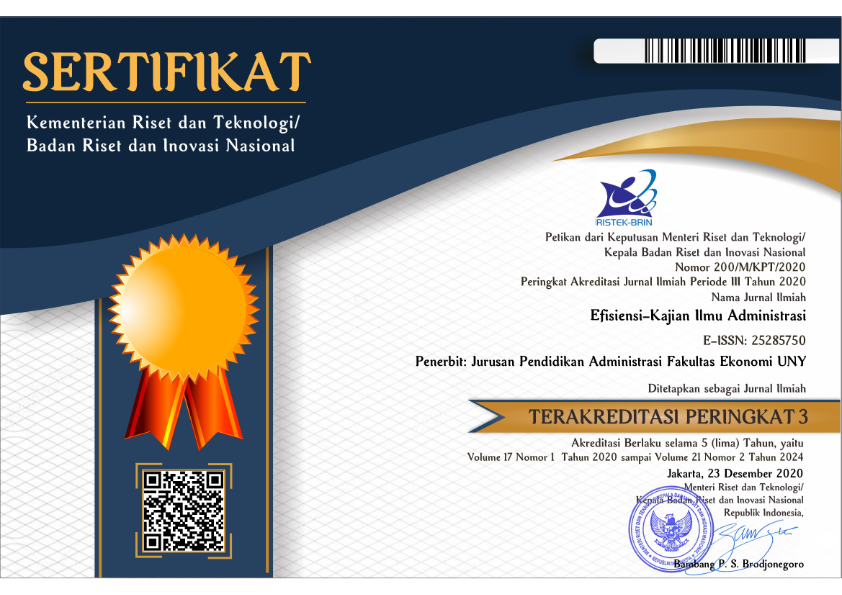E-TRUST DAN REPURCHASE INTENTION: STUDI INTERAKSI DENGAN E-WOM DI EKOSISTEM E-COMMERCE
Downloads
Abstrak: E-Trust dan Repurchase Intention: Studi Interaksi dengan E-WOM di Ekosistem E-Commerce. Perkembangan teknologi digital telah mendorong peningkatan penggunaan platform e-Commerce sebagai media utama dalam transaksi perdagangan. Penelitian bertujuan menganalisis: 1) pengaruh e-Trust terhadap e-WOM; 2) pengaruh e -WOM terhadap Online Repurchase Intention; 3) E-Trust terhadap Online Repurchase Intention; 4) E-Trust terhadap Online Repurchase Intention melalui e-WOM. Penelitian ini menggunakan pendekatan kuantitatif dengan analisis jalur. Data dikumpulkan melalui kuesioner yang dirancang dengan skala Likert, yang disebarkan kepada konsumen e-Commerce yang memiliki pengalaman pembelian ulang. Analisis statistik menggunakan SmartPLS 3.0 mengonfirmasi validitas, reliabilitas, serta mendukung hipotesis. Hasil penelitian menunjukkan bahwa e-Trust memiliki pengaruh positif dan signifikan terhadap e-WOM; e-WOM memiliki pengaruh positif dan signifikan terhadap Online Repurchase Intention; e-Trust tidak memiliki pengaruh signifikan langsung terhadap Online Repurchase Intention; e-WOM terbukti menjadi variabel mediasi yang signifikan dalam hubungan antara e-Trust dan Online Repurchase Intention. Temuan ini menegaskan pentingnya e-Trust dalam membangun e-WOM yang pada akhirnya mendorong Online Repurchase Intention melalui mekanisme mediasi e-WOM.
Kata Kunci: e-Commerce; e-Trust; e-WOM; Online Repurchase Intention
Abstract: E-Trust and Repurchase Intention: An Interaction Study with E-WOM in the E-Commerce Ecosystem. The development of digital technology has driven the increasing use of e-Commerce platforms as the primary medium for trade transactions. This study aims to analyze: 1) the effect of e-Trust on e-WOM; 2) the effect of e-WOM on Online Repurchase Intention; 3) the effect of e-Trust on Online Repurchase Intention; and 4) the effect of e-Trust on Online Repurchase Intention mediated by e-WOM. A quantitative approach with path analysis was employed. Data were collected using a Likert-scale questionnaire distributed to e-Commerce consumers with repurchase experience. Statistical analysis using SmartPLS 3.0 confirmed the validity and reliability of the model while supporting the hypotheses. Results indicate that e-Trust positively and significantly affects e-WOM, e-WOM positively and significantly impacts Online Repurchase Intention, e-Trust does not directly influence Online Repurchase Intention, and e-WOM serves as a significant mediator between e-Trust and Online Repurchase Intention. These findings emphasize the importance of e-Trust in fostering e-WOM to drive Online Repurchase Intention through mediation.
Keywords: e-Commerce; e-Trust; e-WOM; Online Repurchase Intention
Downloads
Arisandi, Y. T. (2018). Kebijakan dan Manajemen Publik Efektivitas Penerapan E-Commerce Dalam Perkembangan Usaha Kecil Menengah Di Sentra Industri Sandal Dan Sepatu Wedoro Kabupaten SidoARJO. Jurnal Kebijakan Manajemen Dan Publik8, 6(2), 1.
Badan Pusat Statistik. (2022). Statistik E-Commerce 2022-2023 (1st ed.). Badan Pusat Statistik. https://www.bps.go.id/id/publication/2023/09/18/f3b02f2b6706e104ea9d5b74/statistik-ecommerce-2022-2023.html
Banowati, A. I. (2022). Pengaruh Harga, Promosi dan Kepercayaan terhaap Keputusan Pembelian Online Shopee di Bandar Lampung. Universitas Lampung, 8.5.2017, 2003–2005.
Barreto, A. M. (2014). The word-of-mouth phenomenon in the social media era. International Journal of Market Research, 56(5), 631–654. https://doi.org/10.2501/IJMR-2014-043
Bickart, B., & Schindler, R. M. (2001). Internet Forums As Influential. Journal of Interactive Marketing, 15(3), 31–40.
Canhoto, A. I., & Clark, M. (2013). Customer service 140 characters at a time: The users' perspective. Journal of Marketing Management, 29(5–6), 522–544. https://doi.org/10.1080/0267257X.2013.777355
Dellarocas, C. (2002). The Digitization of Word of Mouth: Promise and Challenges of Online Reputation Mechanisms. 1–38.
Eid, M. I. (2011). Determinants of e-commerce customer satisfaction, trust, and loyalty in Saudi Arabia. Journal of Electronic Commerce Research, 12(1), 78–93.
Erkan, I., & Evans, C. (2016). The influence of eWOM in social media on consumers' purchase intentions: An extended approach to information adoption. Computers in Human Behavior, 61, 47–55. https://doi.org/10.1016/j.chb.2016.03.003
Farías, P. (2017). Identifying the factors that influence eWOM in SNSs: the case of Chile. International Journal of Advertising, 36(6), 852–869. https://doi.org/10.1080/02650487.2017.1364033
Ghozali, I., dan Latan, H. (2015). Konsep, Teknik, Aplikasi Menggunakan Smart PLS 3.0 Untuk Penelitian Empiris. Semarang: Badan Penerbit Universitas Diponegoro
Ginting, Y. M., Chandra, T., Miran, I., & Yusriadi, Y. (2023). Repurchase Intention of e-commerce customers in Indonesia: An overview of the effect of e-service quality, e-word of mouth, customer trust, and customer satisfaction mediation. International Journal of Data and Network Science, 7(1), 329–340. https://doi.org/10.5267/j.ijdns.2022.10.001
Goyette, I., Richard, L., Bergeron, J., & Marticotte, F. (2010). Word-of-mouth measurement scale for eservice context. Canadian Journal of Administrative Sciences, 27(1), 5–23.
Gruen, T. W., Osmonbekov, T., & Czaplewski, A. J. (2006). eWOM: The impact of customer-to-customer online know-how exchange on customer value and loyalty. Journal of Business Research, 59(4), 449–456. https://doi.org/10.1016/j.jbusres.2005.10.004
Karmawan, I. G. M. (2014). Dampak Peningkatan Kepuasan Pelanggan dalam Proses Bisnis E-Commerce pada Perusahaan Amazon.Com. ComTech: Computer, Mathematics and Engineering Applications, 5(2), 748. https://doi.org/10.21512/comtech.v5i2.2237
King, R. A., Racherla, P., & Bush, V. D. (2014). What we know and don't know about online word-of-mouth: A review and synthesis of the literature. Journal of Interactive Marketing, 28(3), 167–183. https://doi.org/10.1016/j.intmar.2014.02.001
Lazarsfeld, E. K. & P. F. (2006). Personal Influence: The Part Plyed by People in the Flow of Mass Communications.
Megantara, I. M. T. (2016). Penentu Niat Pembelian Kembali Tiket Pesawat Secara Online Pada Situs Traveloka . Com Fakultas Ekonomi dan Bisnis Universitas Udayana , Bali , Indonesia Fakultas Ekonomi dan Bisnis Universitas Udayana , Bali , Indonesia. 5(8), 1–28.
Nuseir, M. T., El Refae, G. A., Aljumah, A., Alshurideh, M., Urabi, S., & Kurdi, B. Al. (2023). Digital Marketing Strategies and the Impact on Customer Experience: A Systematic Review. Studies in Computational Intelligence, 1056(March), 21–44. https://doi.org/10.1007/978-3-031-12382-5_2
Shim, S., Eastlick, M. A., Lotz, S. L., & Warrington, P. (2001). An online pRepurchase Intentions model: The role of intention to search: Best Overall Paper Award - The Sixth Triennial AMS/ACRA Retailing Conference, 2000. Journal of Retailing, 77(3), 397–416. https://doi.org/10.1016/S0022-4359(01)00051-3
Wen, C., & Prybutok, V. R. (2011). An Integrated Model FoR University of North Texas. Journal of Computer Information Systems, February 2011, 14–23.
Yoon, S. J. (2012). A social network approach to the influences of shopping experiences on e-WOM. Journal of Electronic Commerce Research, 13(3), 213–223.












































